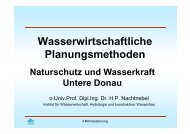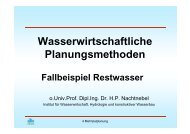User's guide of Proceessing Modflow 5.0
User's guide of Proceessing Modflow 5.0
User's guide of Proceessing Modflow 5.0
Create successful ePaper yourself
Turn your PDF publications into a flip-book with our unique Google optimized e-Paper software.
190 Processing <strong>Modflow</strong><br />
size <strong>of</strong> the time marks is defined by Size (in pixels). The default value <strong>of</strong> Size is 10 for<br />
the top view window and 3 for the cross-section windows. The sizes can be ranged from<br />
1 to 2,147,483,647.<br />
- Simulation Mode: PMPATH can be used to calculate flowlines or pathlines. Flowlines<br />
indicate the instantaneous direction <strong>of</strong> flow throughout a system (at all times <strong>of</strong> a<br />
steady-state flow simulation or at a given time step <strong>of</strong> a transient flow simulation).<br />
Pathlines map the route that an individual particle <strong>of</strong> water follows through a region <strong>of</strong><br />
flow during a steady-state or transient condition. In a steady-state flow system pathlines<br />
will coincide with flowlines. In this case, only the option Flowline, use the flow field<br />
from the current time step is available. In the case <strong>of</strong> a transient flow simulation that<br />
groundwater flow varies from time step to time step, the flowlines and pathlines do not<br />
coincide. Use the option Pathlines, use transient flow fields to calculate transient<br />
pathlines.<br />
- Stop Conditions: In general, particles will stop when the allowed travel time defined in<br />
Tracking Step is reached or when the particles reach specified head cells. In addition to<br />
these conditions, two stop conditions are available:<br />
1. Particles stop, when they enter cells with internal sinks:<br />
The flow model MODFLOW includes the options to simulate wells, drains, rivers,<br />
general-head boundaries, streams, evapotranspiration and recharge. Except the last<br />
two options, they are treated as internal distributed sources or sinks by PMPATH. If<br />
the internal sink <strong>of</strong> a cell is sufficiently strong, flow will be into the cell from all cell<br />
faces. In that case, every particle that enters the cell will be discharged. If the sink is<br />
weak, flow will be into the cell from some cell faces and a part <strong>of</strong> flow will leave the<br />
cell through another faces. A particle entering such a cell may be discharged or may<br />
leave the cell again. In the finite-difference approach, however, it is impossible to<br />
determine whether that particle should be discharged or pass through the cell. If this<br />
option is selected, particles will be discharged when they enter cells with internal<br />
sinks, regardless <strong>of</strong> the flow condition.<br />
2. Particles stop, when the simulation time limit is reached.<br />
This option is only available, if the simulation mode Pathlines, use transient flow<br />
fields is selected. In PMPATH, the starting time <strong>of</strong> each particle is always the<br />
beginning <strong>of</strong> the time step defined in Current Time. For the forward particle tracking<br />
scheme, the simulation time limit is the end <strong>of</strong> a transient flow simulation. For the<br />
backward particle tracking scheme, on the other hand, the simulation time limit is the<br />
beginning <strong>of</strong> the simulation. Backward particle tracking will not work, if this stop<br />
option is checked and particles are started from the beginning <strong>of</strong> a transient flow<br />
4.3 PMPATH Options Menu
















